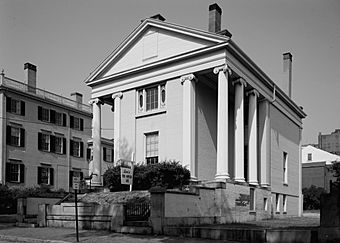Charles Q. Clapp House facts for kids
|
Charles Q. Clapp House
|
|
|
U.S. Historic district
Contributing property |
|

Front of the Charles Q. Clapp House, HABS photo, 1965
|
|
| Location | 97 Spring Street, Portland, Maine |
|---|---|
| Area | 0.3 acres (0.12 ha) |
| Built | 1832 |
| Architect | Clapp, Charles Q. |
| Architectural style | Greek Revival |
| Part of | Spring Street Historic District (ID70000043) |
| NRHP reference No. | 72000072 |
Quick facts for kids Significant dates |
|
| Added to NRHP | February 23, 1972 |
| Designated CP | April 3, 1970 |
The Charles Q. Clapp House is a very old and important building located at 97 Spring Street in Portland, Maine. It was built in 1832 and is a great example of a building style called Greek Revival architecture. This style was popular because it looked like ancient Greek temples.
The house was probably designed by its first owner, Charles Q. Clapp. For many years in the 1900s, it was home to the Portland School of Fine and Applied Art, which is now known as the Maine College of Art. Today, the Portland Museum of Art owns the house. Because of its history and special design, it was added to the National Register of Historic Places in 1972.
Contents
What Does the Clapp House Look Like?
The Clapp House stands on the north side of Spring Street in Downtown Portland. It's right next to the McLellan-Sweat Mansion, which is another famous building that is part of the Portland Museum of Art.
Main Features of the House
The house has two floors and is built with strong brick walls. It sits on a tall foundation made of granite. The roof is pointed, like a triangle. The front of the house faces south and has three main sections. The outside sections have tall, grooved columns called Ionic columns. The middle section has similar columns, but they are flat against the wall, called pilasters.
The middle section on the first floor has a large window. Above it, on the second floor, there's a smaller window with two oval windows on each side. These oval windows have fancy carvings around them.
Side Porches and Details
On each side of the house, there's a porch that is set back into the building. These porches are held up by three more Ionic columns. The floors of the porches are made of colorful tiles laid out in cool patterns. You can get to each porch by walking up a separate granite staircase from the front.
Who Was Charles Q. Clapp?
The Charles Q. Clapp House was built in 1832. It's believed that Charles Q. Clapp himself designed it. He was the son of Asa Clapp, who was one of the richest businessmen in Portland. Charles Q. Clapp worked in real estate, buying and selling land and buildings in the city.
Clapp's Design Ideas
Some of the designs you see in and on the house come from popular books about Greek Revival style. These books included The Practical House Carpenter by Asher Benjamin and Civil Architecture by Edward Shaw. Charles Q. Clapp also helped change the McLellan-Sweat Mansion to fit the Greek Revival style. He also built the Charles Q. Clapp Block, which is one of Portland's oldest business buildings still standing today.
What Happened to the House Over Time?
In the 1860s, the house belonged to Augustus Stevens, who was the mayor of Portland. The house was lucky because it survived a huge fire in 1866 that destroyed much of the city.
A Safe Place After the Fire
After the big fire, many important city and bank records were kept safe in the Clapp House. It's likely that some city business was also done there, since the original city hall was destroyed by the fire.
From Art School to Museum Property
In 1914, an organization called the Portland Society of Art bought the building. They turned it into a school for art, with help from an architect named John Calvin Stevens. In 1982, the society split up its property between the Portland Museum of Art (PMA) and what is now the Maine College of Art (MECA).
MECA continued to use the Clapp House for its art classes until the 1990s. Then, MECA moved to another building downtown. After that, the ownership of the Clapp House went back to the Portland Museum of Art.



